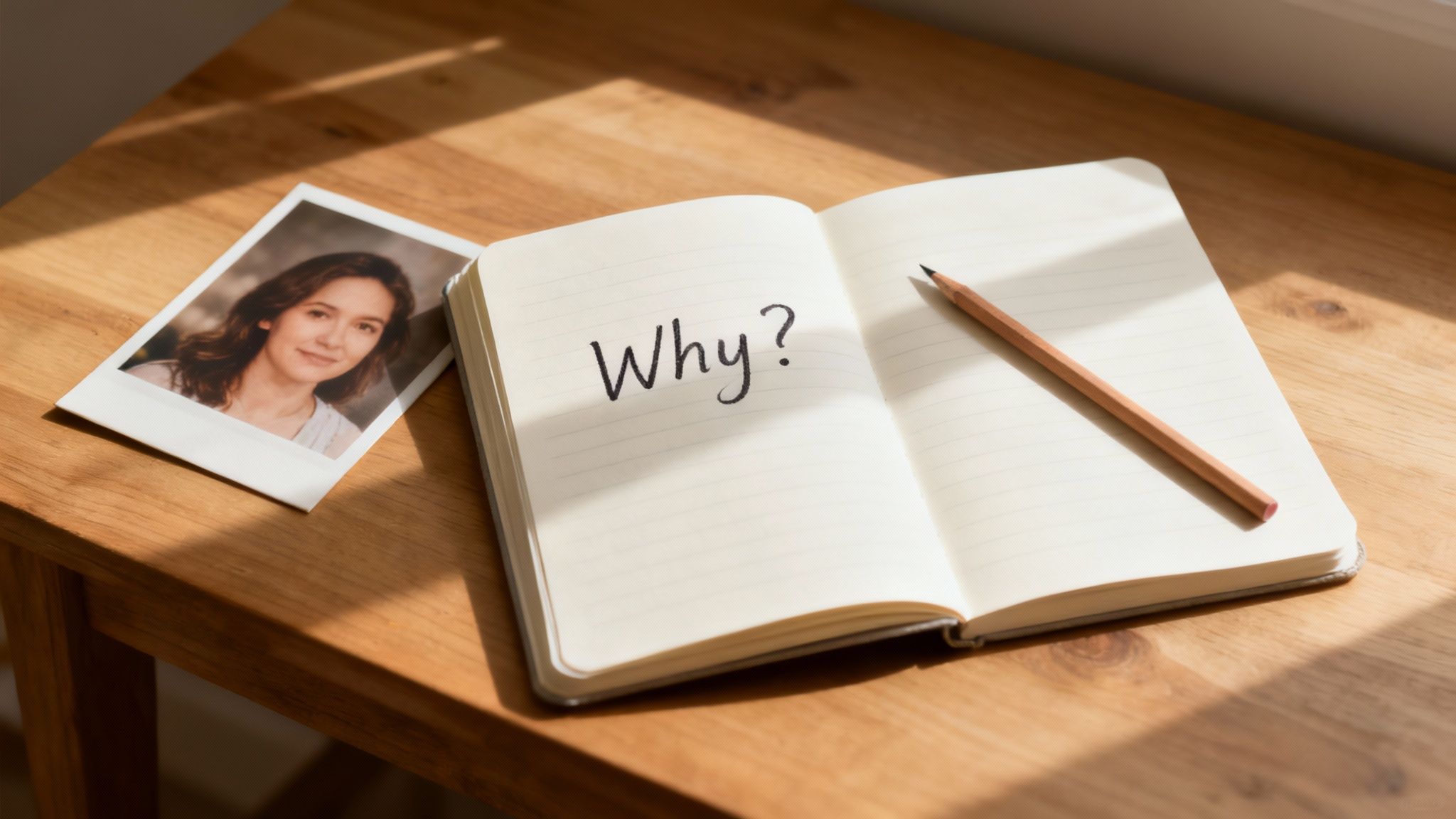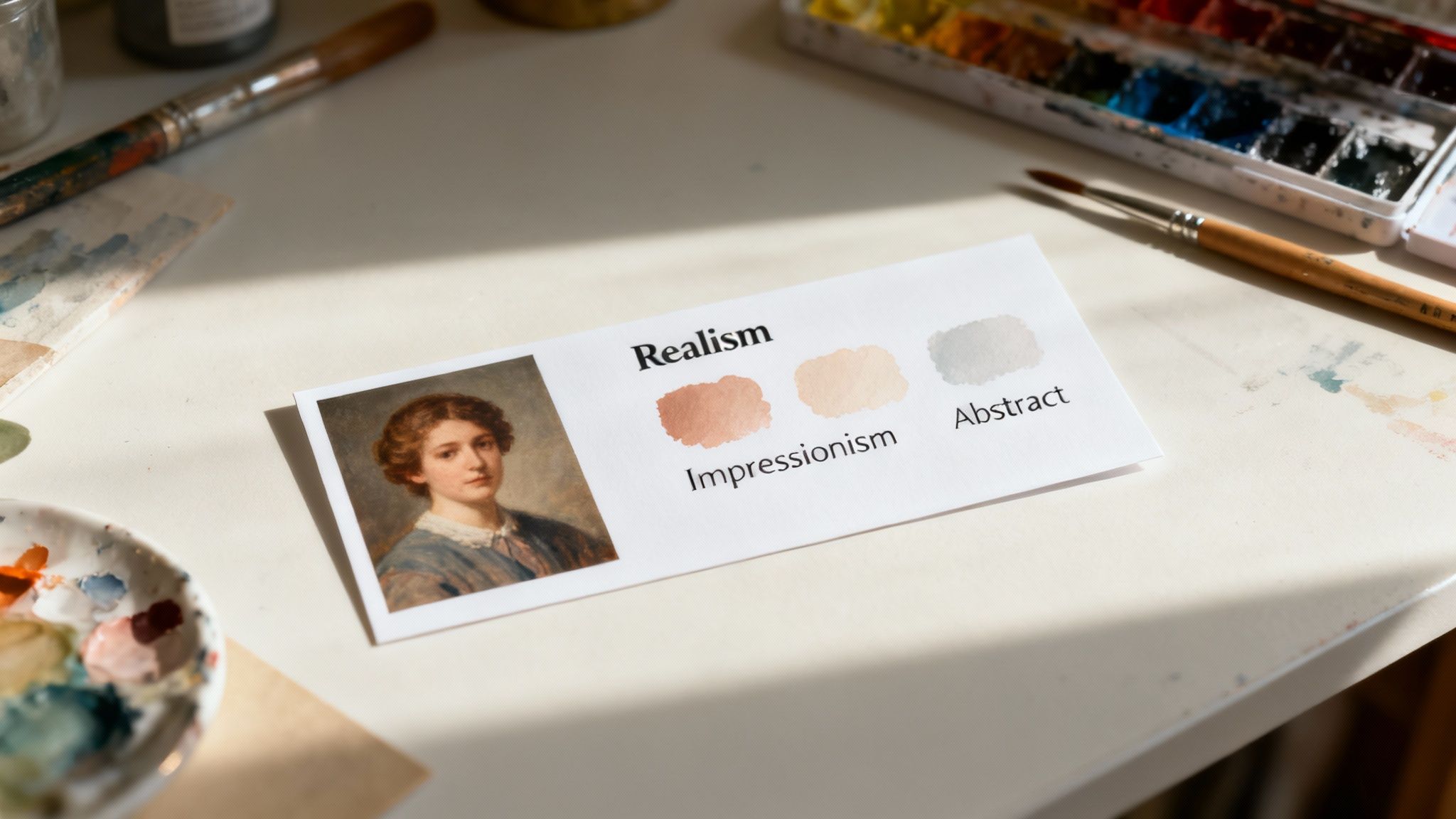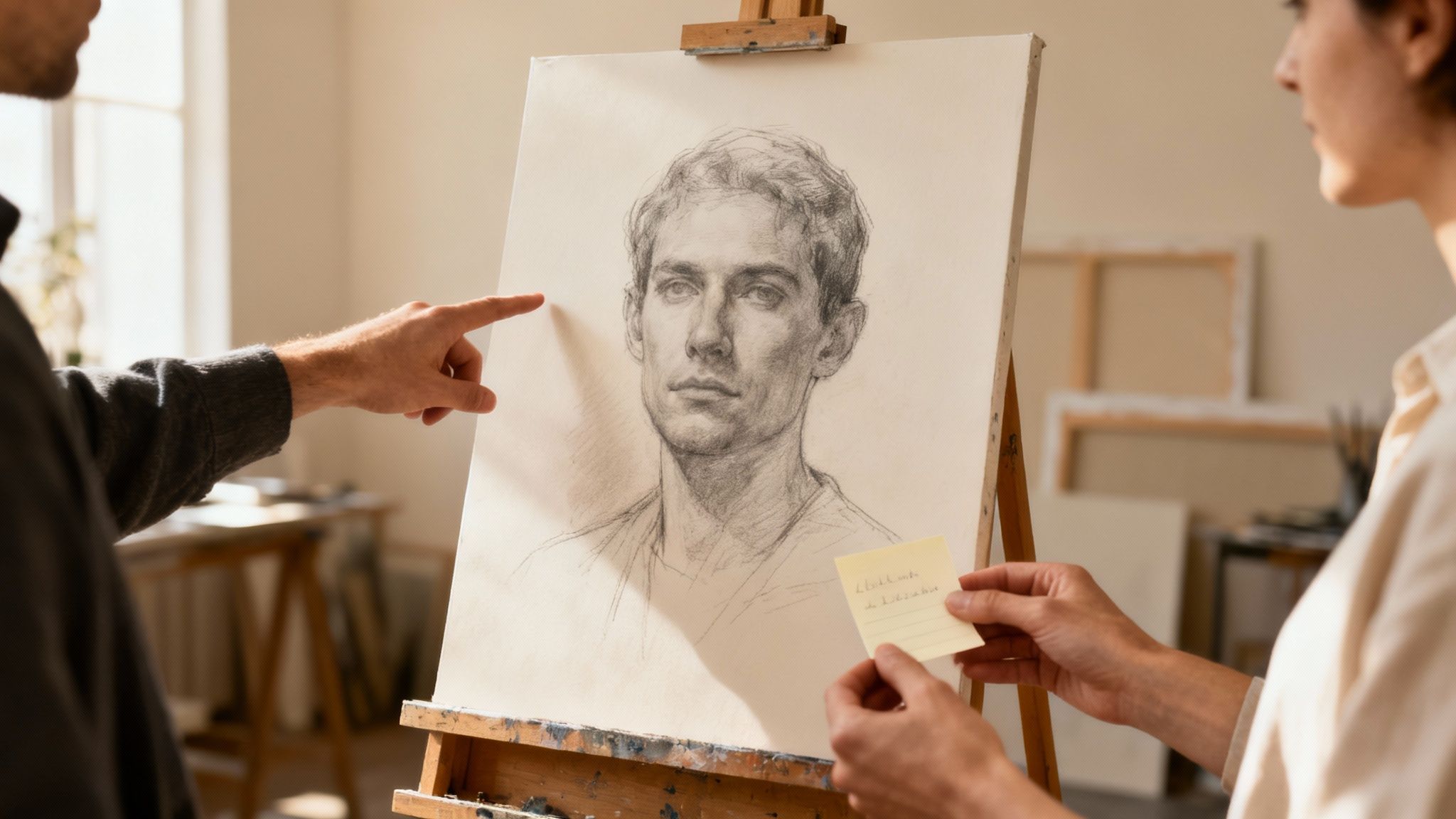Christmas Sale: BIG 50% OFF to Preserve Your Family Story.
The Art of Being Seen: A Masterclass in Commissioning Your Custom Portrait from a Photograph

To commission a portrait from a photo is to engage in one of the most profound acts of translation. It is the process of converting a fleeting digital moment—a pixelated memory—into a singular, tangible artifact imbued with emotion and permanence. This is not a transaction; it is a creative and philosophical journey. The objective is not merely to acquire a painting but to participate in the creation of a legacy.
This guide is structured as a masterclass, designed to elevate you from client to a true collaborator. By mastering the core principles of the commissioning process, you will ensure the final artwork is not simply a representation of a person, but a definitive statement of their essence.
Phase I: Defining the Intention (The 'Why')

Before an artist is selected, before a medium is chosen, the most critical work begins within you. A common misstep in commissioning a portrait from a photo is to believe the photograph itself is the subject. This is a fundamental error. The photo is not the subject; it is merely the vessel. The true subject is the emotion, the memory, the legacy, or the specific quality that the photograph represents.
This initial phase of self-reflection is what separates a mere likeness from a resonant work of art. You must define the portrait’s ultimate purpose. Is it an act of remembrance, designed to distill the enduring spirit of a loved one into a timeless memorial? Is it a celebration of resilience, marking a personal or professional milestone achieved against all odds? Or is it a bold statement of identity, capturing a moment of profound self-awareness and quiet confidence?
This core intention becomes the North Star for the entire project, guiding every subsequent decision with clarity and purpose. It transforms the commission from an aesthetic exercise into a deeply personal undertaking.
The Socratic Inquiry of Commissioning
To excavate this intention, you must look beyond the surface of the image and interrogate its emotional significance. Pose these questions to yourself with intellectual honesty:
- What singular emotion must this portrait evoke upon every viewing? Is it joy, serenity, strength, or a poignant nostalgia? Be precise.
- For whom does this portrait exist? Is it a private totem for personal reflection, a public statement in a professional setting, or a foundational heirloom for future generations?
- Project forward two decades. What narrative should this painting convey about this individual, this relationship, or this specific moment in time?
- What unseen quality—a subtle strength in the posture, a flicker of defiance in the eyes—is more vital to capture than photographic accuracy?
Answering these questions is the act of writing the philosophical preamble to your creative brief. You graduate from the simplistic request, "I want a painting of this photo," to the sophisticated directive, "I want a portrait that communicates the quiet dignity my father possessed." This clarity is invaluable.
The Photograph: Reference, Not Regulation
Consider the chosen photograph as a musical score. The notes are fixed, providing structure and form. However, it is the artist’s interpretation—the tempo, the dynamics, the emotional articulation—that breathes life into the composition. Your stated intention provides the artist with the essential interpretive key. It empowers them to see beyond the literal data of the photo and to capture the spirit that animates it.
When you begin with this profound clarity, you ensure the final portrait from photo is not merely hung on a wall, but that it resonates with the very soul of its subject.
Phase II: Translating Vision to Style (The 'How')

With a defined intention, the next phase is to select the visual language best suited to express it. This moves beyond a superficial choice of "oil vs. acrylic." We must engage in what I term Stylistic Alignment: the deliberate pairing of a photograph’s intrinsic mood with the artistic style that will most powerfully amplify it. The style is not decorative; it is the primary vehicle for your emotional and philosophical intent.
A photograph is a record of a moment. An artist's style is the voice that transforms that record into a timeless story. The correct stylistic choice can elevate a simple image into an icon.
The Art of Stylistic Alignment
Consider a sharp, formal photograph of a corporate leader. A hyper-realist execution, with its meticulous detail and crisp lines, would underscore the subject’s authority and precision. The style aligns perfectly with the intended message of power and control.
Now, imagine a soft-focus, candid photograph of a couple sharing a quiet, intimate moment. An expressionistic approach, with visible brushwork and an emphasis on light and shadow, would better capture the fleeting, emotional essence of their connection. Verisimilitude is sacrificed for emotional truth. This is the essence of masterful portraiture. The aesthetic choice serves the narrative.
This is where you must consider the artist's technical lexicon:
- Hyper-realism: Best for photos where detail and accuracy are paramount to the story.
- Expressionism: Ideal for images where capturing a powerful mood or fleeting emotion is the primary goal.
- Impressionism: Suited for candid moments, capturing the sensation of light and movement over static detail.
- Classical Realism: Perfect for creating a sense of timeless dignity and permanence, often referencing historical portraiture.
Choosing a style is not a matter of personal taste alone. It is a strategic decision about what feels most authentic to the intention you have already defined. If you wish to explore this further, our definitive guide on how to turn a photo into a painting examines these stylistic choices in greater depth.
A Matrix of Mood and Method
To assist in this critical decision, consult the following framework. Identify the dominant quality of your source photograph and consider the artistic response that will best serve your core intention.
Photo Mood → Artistic Response Matrix
| Photographic Mood or Quality | Potential Artistic Response | Desired Emotional Outcome |
|---|---|---|
| Formal, Crisp, Professional | Hyper-realism / Classical Realism | Authority, Precision, Timeless Dignity |
| Candid, Joyful, Spontaneous | Expressionism / Impressionism | Energy, Authenticity, Captured Motion |
| Soft, Romantic, Intimate | Soft Realism / Watercolor Glazing | Dreaminess, Delicacy, Tenderness |
| Dramatic, High-Contrast, Moody | Chiaroscuro / Heavy Impasto | Depth, Intensity, Emotional Gravitas |
| Vintage, Nostalgic, Faded | Sepia Tones / Sketch Style | Sentimentality, Heritage, Classicism |
This matrix serves as an intellectual starting point. The most successful portraits are born from a sophisticated dialogue between a client's clear vision and an artist's interpretive skill.
In an age saturated with ephemeral digital images, the demand for tangible, meaningful art has surged. The global photography services market, valued at $55.6 billion in 2023, reflects a profound human desire to solidify our personal narratives in a lasting form.
The correct artistic style does not merely copy the photograph; it decodes it. Your task is to select the style that renders the emotional subtext of your photograph visible, transforming a simple image into a resonant work of art.
Phase III: Mastering the Partnership (The 'Who')

The final phase of this masterclass concerns the relationship between patron and artist. A masterful portrait is the product of a masterful partnership. It is crucial to understand that a true artist is not a service provider or a high-fidelity printer; they are an interpreter and a collaborator. Their role is to synthesize your intention with their unique skill and vision to create something greater than the source material.
This relationship must be founded upon clear communication and mutual respect. The primary tool for achieving this is the Creative Brief.
The Indispensable Creative Brief
A Creative Brief is a concise, definitive document that articulates your vision. It is not a list of demands but a declaration of artistic goals. This brief is your opportunity to communicate desired deviations from the photograph—the very instructions that elevate the work from replication to interpretation.
A sophisticated brief contains specific, actionable directives that guide the artist while preserving their creative autonomy.
- To alter context, one might state: "Capture the subject’s expression with absolute fidelity, but replace the distracting background with muted, abstract tones of charcoal and slate to evoke a more contemplative mood."
- To enhance emotion, one might propose: "I value the candid nature of this photograph. I ask that you emphasize the warm, golden light of the late afternoon to amplify the scene’s nostalgic quality."
- To consolidate elements, one could direct: "Please render the figure from Photo A, but incorporate the more serene facial expression from Photo B. The goal is to create a composite that feels more representative than either individual shot."
This document is the shared constitution for the project. It clarifies priorities, manages expectations, and empowers the artist to apply their talent where it matters most to you.
A great portrait is born from a great partnership. By providing clear direction through a creative brief, you invite the artist into your vision, transforming the process from a simple transaction into a shared artistic journey.
The Curation of Talent and Trust
Once the commission is underway, your role transitions to one of thoughtful review and educated trust. The artist will provide preliminary sketches or digital mock-ups. This is the moment for precise, constructive feedback, always anchored to the agreed-upon terms of the Creative Brief.
Finding an artist who possesses not only technical mastery but also this essential collaborative spirit can be daunting. A curated platform like Novakara.com is built to solve this exact challenge. Artists are vetted not only for their skill but for their demonstrated ability to engage in the sophisticated partnership this guide describes, ensuring the entire process—from intention to execution—is handled with the seriousness and respect it deserves. This is the curated solution for the complex guidance provided herein. You can explore more about the specifics in our detailed guide on commissioning a portrait painting.
Ultimately, the act of commissioning a portrait is an act of trust—trust in your own vision, trust in the artist's skill, and trust in the collaborative process to produce an object of lasting personal and aesthetic value.
At Novakara, we are dedicated to curating this profound journey. We believe the process of creating your portrait should be as meaningful and beautiful as the final work of art. Explore our process and start your commission today.


